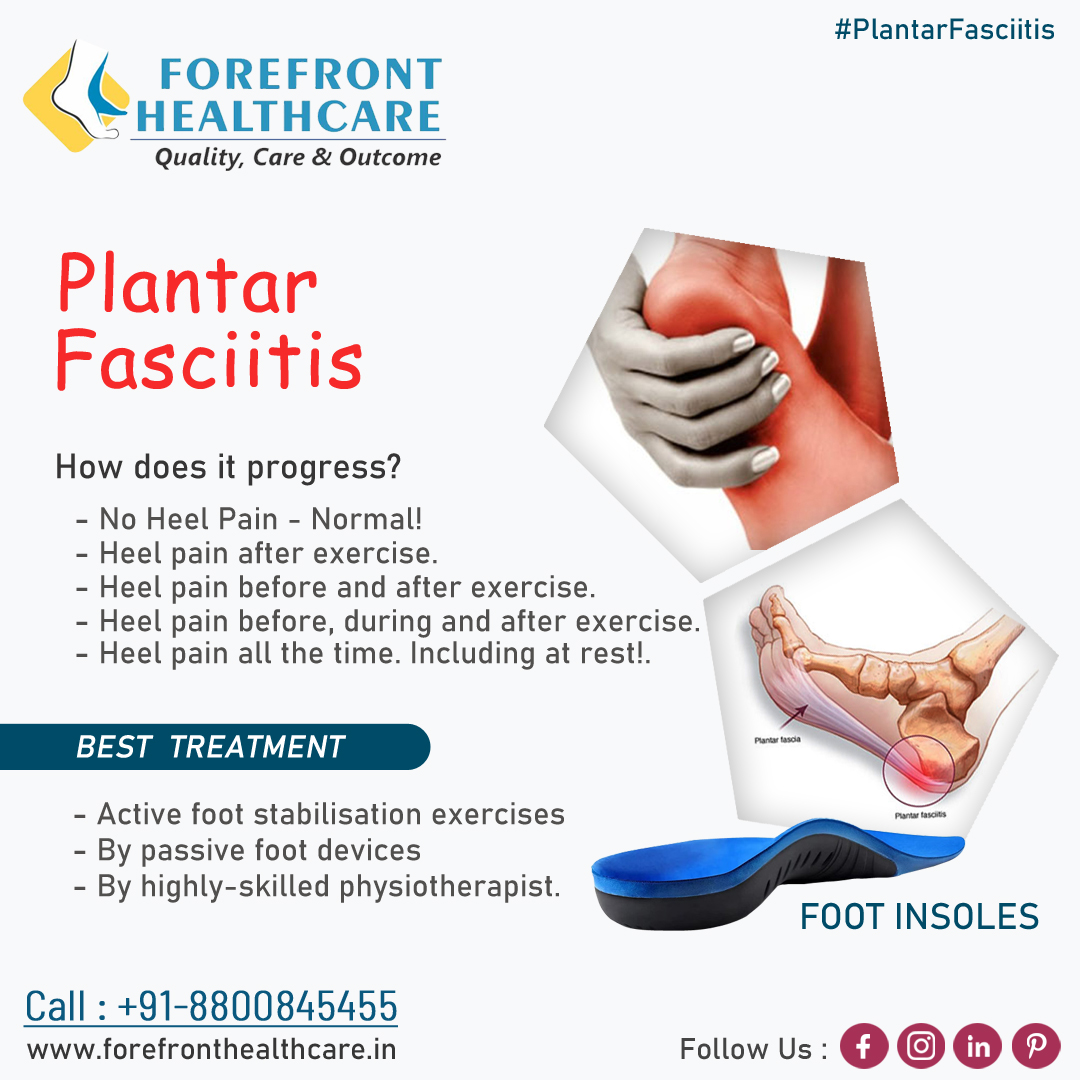Plantar Fasciitis?

What is Plantar Fasciitis?
Plantar fasciitis is one of the most common sources of heel pain.
Your plantar fascia is a thick fibrous band of connective tissue originating on the bottom surface of the calcaneus (heel bone) and extending along the sole of the foot towards the toes. Your plantar fascia acts as a passive limitation to the over flattening of your arch. When your plantar fascia develops micro tears or becomes inflammed it is known as plantar fasciitis.
What Causes Plantar Fasciitis?
Plantar fasciitis is one of those injuries that magically seems to appear for no apparent reason. However, plantar fasciitis is caused by one of two methods. They are either traction or compression injuries.
Plantar fasciitis is most often associated with impact and running sports, especially those that involve toe running rather than heel running styles.
It is also commonly diagnosed in individuals with poor foot biomechanics that stress the plantar fascia. Flat feet or weak foot arch control muscles are two common causes of plantar fasciitis.
Traction Plantar Fasciitis
Plantar fasciitis symptoms are usually exacerbated via "traction" (or stretching) forces on the plantar fascia. In simple terms, your plantar fascia is repeatedly overstretched. The most common reason for the overstretching is an elongated arch due to either poor foot biomechanics (eg overpronation) or weakness of your foot arch muscles.
Compression Plantar Fasciitis
Compression type plantar fascia injuries have a traumatic history. Landing on a sharp object that bruises your plantar fascia is your most likely trauma.
The location of plantar fasciitis pain will be further under your arch than under your heel, which is more likely to be a fat pad contusion if a single trauma caused your pain.
The compression type plantar fasciitis can be confused with a fat pad contusion that is often described as a "stone bruise".
What are the Symptoms of Plantar Fasciitis?
You'll typically first notice early plantar fasciitis pain under your heel or in your foot arch in the morning or after resting.Your heel pain will be worse with the first steps and improves with activity as it warms up.
How Does Plantar Fasciitis Progress?
As plantar fasciitis deteriorates, the pain will be present more often. You can determine what stage you are in using the following guidelines:
- No Heel Pain - Normal!
- Heel pain after exercise.
- Heel pain before and after exercise.
- Heel pain before, during and after exercise.
- Heel pain all the time. Including at rest!
This symptom progression is consistent with the four stages of a typical overuse injury.
Ultimately, further trauma and delayed healing will result in the formation of calcium (bone) within the plantar fascia. When this occurs adjacent to the heel bone it is known as heel spurs, which have a longer rehabilitation period.
How is Plantar Fasciitis Diagnosed?
Plantar fasciitis is usually diagnosed by your physiotherapist or sports doctor based on your symptoms, history and clinical examination.
After confirming your plantar fasciitis they will investigate WHY you are likely to be predisposed to plantar fasciitis and develop a treatment plan to decrease your chance of future bouts.
X-rays may show calcification within the plantar fascia or at its insertion into the calcaneus, which is known as a calcaneal or heel spur.
Ultrasound scans and MRI are used to identify any plantar fasciitis tears, inflammation or calcification.
Pathology tests (including screening for HLA B27 antigen) may identify spondyloarthritis, which can cause symptoms similar to plantar fasciitis.
Risk Factors for Plantar Fasciitis
You are more likely to develop plantar fasciitis if you are:
Active - Sports that place excessive stress on the heel bone and attached tissue, especially if you have tight calf muscles or a stiff ankle from a previous ankle sprain, which limits ankle movement eg. Running, ballet dancing and aerobics.
Diabetes- Although doctors don't know why plantar fasciitis occurs more often in people with diabetes.
Plantar Fasciitis Treatment
The good news is that plantar fasciitis is reversible and very successfully treated. About 90 percent of people with plantar fasciitis improve significantly within two months of initial treatment.
If your plantar fasciitis continues after a few months of conservative treatment, your doctor may inject your heel with steroidal anti-inflammatory medications (corticosteroid). Cortisone injections have been shown to have short-term benefits but they actually retard your progress in the medium to long-term, which usually means that you will suffer recurrent bouts for longer.
What is the Best Treatment for Plantar Fasciitis?
Due to poor foot biomechanics being the primary cause of your plantar fasciitis, it is vital to thoroughly assess and correct your foot and leg biomechanics to prevent future plantar fasciitis episodes or the development or progression of a heel spur.
Your physiotherapist is highly-skilled in foot control assessment and its dynamic biomechanical correction. Depending upon your specific clinical assessment, your physiotherapist may provide you with manual therapy techniques such as joint mobilisations to loosen stiff joints, soft tissue massage or release, muscle flexibility or stretches, foot taping, foot, and lower limb strengthening exercises and occasionally night splints. The treatment of plantar fasciitis does vary from person to person so please seek the advice of your foot care practitioner.
They may recommend that you seek the advice of a podiatrist, who is an expert in the prescription on passive foot devices such as orthotics. Foot orthosis have been shown to potentially assist some sufferers of plantar fasciitis.
Active foot stabilisation exercises are an excellent long-term solution to prevent and control plantar fasciitis that may be prescribed by your physiotherapist.
To meet the demand of clients Forefront Healthcare provides diversified services and Plantar Fasciitis insole products in kaushambi Ghaziabad India.

